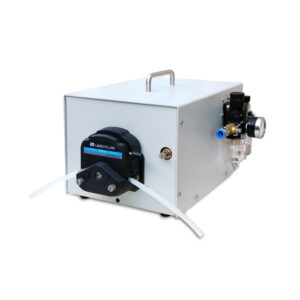Stepper motor peristaltic pumps have gained widespread popularity in industries where precise fluid transfer is essential. These pumps combine the advantages of peristaltic pumping technology with the precise control capabilities of stepper motors. In this article, we will explore how stepper motor peristaltic pumps work, their unique design features, and the advantages they offer in various applications.
Peristaltic Pumping Mechanism
- Overview
Peristaltic pumps operate on the principle of peristalsis, mimicking the natural movement of muscles in the human body. They utilize a flexible tube or hose and a series of rollers or shoes to create a squeezing action that propels the fluid forward. - Pumping Action
As the rollers or shoes rotate, they compress the flexible tube against the pump housing, creating a positive displacement action. This compression generates a vacuum effect, drawing the fluid into the tube from the inlet side and propelling it towards the outlet.
Stepper Motor Control
- Stepper Motor Basics
A stepper motor is a type of brushless electric motor that divides a full rotation into a series of equal steps. It provides precise control over the motor’s position and speed, making it ideal for applications that require accurate and repeatable movements. - Stepper Motor Control in Peristaltic Pumps
In stepper motor peristaltic pumps, the stepper motor is used to control the rotation of the pump head’s rollers or shoes. By precisely controlling the stepper motor’s steps and speed, the pump can accurately control the flow rate and volume of fluid being transferred.
Working Principles of Stepper Motor Peristaltic Pumps
- Tube Loading
The flexible tube or hose is loaded into the pump head, passing through the rollers or shoes. The tube is typically made of materials that are compatible with the fluid being transferred and can be easily replaced when necessary. - Step Sequence
The stepper motor follows a predefined step sequence to rotate the rollers or shoes. The number of steps per revolution determines the resolution and precision of the pump’s flow rate control. - Fluid Transfer
As the rollers or shoes rotate, they sequentially compress the flexible tube against the pump housing. This action creates a positive displacement, propelling the fluid forward through the tube from the inlet to the outlet. The fluid remains completely contained within the tube, preventing contact with the pump components and minimizing the risk of contamination. - Control and Adjustment
The stepper motor’s speed and step sequence can be adjusted to control the flow rate and volume of fluid being transferred. By precisely controlling the motor’s steps and speed, the pump can achieve accurate dosing, ensuring precise fluid transfer in various applications.
Advantages of Stepper Motor Peristaltic Pumps
- Precise Flow Control
Stepper motor peristaltic pumps offer excellent flow rate control and accuracy. The stepper motor’s ability to provide precise position and speed control allows for fine-tuning of flow rates, ensuring accurate dosing and transfer of fluids. - Repeatability and Consistency
Stepper motors provide excellent repeatability, allowing for consistent fluid transfer over multiple cycles. This is crucial in applications where precise dosing or continuous fluid flow is required. - Versatility and Compatibility
Stepper motor peristaltic pumps can handle a wide range of fluids, including corrosive chemicals, abrasive slurries, and viscous solutions. The compatibility of the pump components and the flexible tube material can be selected to suit the specific fluid properties, ensuring reliable and efficient operation. - Easy Maintenance and Tube Replacement
These pumps are relatively easy to maintain due to their simple design and fewer moving parts. The flexible tube can be easily replaced when necessary, minimizing downtime and reducing maintenance costs. - Contamination Prevention
Stepper motor peristaltic pumps provide excellent fluid containment, preventing contact between the fluid and the pump components. This minimizes the risk of contamination, making them suitable for applications where maintaining fluid purity is critical.
Stepper motor peristaltic pumps combine the advantages of peristaltic pumping technology with the precise control capabilities of stepper motors. Their unique design enables accurate flow rate control, repeatability, versatility, and ease of maintenance. Stepper motor peristaltic pumps find applications in various industries, including pharmaceuticals, laboratory research, chemical processing, and food and beverage. With their precise fluid transfer capabilities, these pumps offer a reliable and efficient solution for applications that require accurate dosing and precise fluid transfer.
